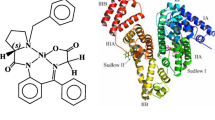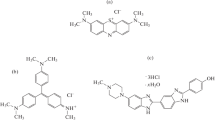Abstract
In this work, the interaction between \({\text{Cu}}\left( {{\text{phen}}} \right)_3^{\,\,2 + } \) and bovine serum albumin (BSA) was investigated by fluorescence spectroscopy combined with UV–vis absorption and circular dichroism (CD) spectroscopic techniques under physiological conditions. The fluorescence data proved that the fluorescence quenching of BSA by \({\text{Cu}}\left( {{\text{phen}}} \right)_3^{\,\,2 + } \) was the result of the \({\text{Cu}}\left( {{\text{phen}}} \right)_3^{\,\,2 + } - {\text{BSA}}\) complex formation. The binding constants (K a) between \({\text{Cu}}\left( {{\text{phen}}} \right)_3^{\,\,2 + } \) and BSA at four different temperatures were calculated according to the modified Stern–Volmer equation. The enthalpy change (ΔH) and entropy change (ΔS) were calculated to be 10.74 kJ mol-1 and 54.35 J mol-1 K-1, respectively, which indicated that electrostatic interactions played a major role in the formation of \({\text{Cu}}\left( {{\text{phen}}} \right)_3^{\,\,2 + } - {\text{BSA}}\) complex. The distance r between the donor (BSA) and acceptor\(\left[ {{\text{Cu}}\left( {{\text{phen}}} \right)_3^{\,\,2 + } } \right]\) was obtained to be 3.55 nm based on Förster’s energy transfer theory. The synchronous fluorescence and CD spectroscopy results showed that the polarity of the residues increased and the lost of the α-helix content of BSA (from 59.84 to 53.70%). These indicated that the microenvironment and conformation of BSA were changed in the presence of \({\text{Cu}}\left( {{\text{phen}}} \right)_3^{\,\,2 + } \).







Similar content being viewed by others
References
Chatterjee S, Srivastava TS (2000) Spectral investigations of the interaction of some porphyrins with bovine serum albumin. J Porphyr Phthalocyanines 4:147–157
Su Kowska A, Rownicka J, Bojko B, Su Kowski W (2003) Interaction of anticancer drugs with human and serum albumin. J Mol Struct 651–653:133–140
Li Y, He WY, Liu JQ (2005) Binding of the bioactive component jatrorrhizine to human serum albumin. Biochim Biophys Acta 1722:15–21
Wang YQ, Zhang HM, Zhang GC, Tao WH, Fei ZH (2007) Spectroscopic studies on the interaction between silicotungstic acid and bovine serum albumin. J Pharm Biomed Anal 43:1869–1875
Guharay J, Sengupta B, Sengupta PK (2001) Protein–flavonol interaction: fluorescence spectroscopic study. Proteins 43:75–81
Zolese G, Falcioni G, Bertoli E (2000) Steady-state and time resolved fluorescence of albumins interacting with N-oleylethanolamine, a component of the endogenous N-acylethanolamines. Proteins 40:39–48
Gelamo EL, Tabak M (2000) Spectroscopic studies on the interaction of bovine (BSA) and human (HSA) serum albumins with ionic surfactants. Spectrochim Acta Part A Mol Biomol Spectrosc 56:2255–2271
Linder MC (2001) Copper and genomic stability in mammals. Mutat Res 475:141–152
Majella G, Vivienne S, Malachy M, Micheal D, Vickie, M (1999) Synthesis and anti-candida activity of copper(II) and manganese(II) carboxylate complexes X-ray crystal structures of [Cu(sal)(bipy)]-C2H5OH-H2O and [Cu(norb)(phen)]-6.5H2O (salH2 = salicylic acid; norbH2 = cis-5-norbornene-endo-2,3-dicarboxylic acid; bipy = 2,2′-bipyridine; phen = 1,10-phenanthroline). Polyhedron 18:2931–2939
Saha DK, Sandbhor U, Shirisha K, Padhye S, Deobagkar D, Anson CE, Powell, AK (2004) A novel mixed-ligand antimycobacterial dimeric copper complex of ciprofloxacin and phenanthroline. Bioorg Med Chem Lett 14:3027–3032
Tümer M, Köksal H, Serin S (1999) Antimicrobial activity studies of the binuclear metal complexes derived from tridentate schiff base ligands. Trans Met Chem 24:414–420
Sigman DS, Perrin DM (1993) Chemical nucleases. Chem Rev 93:2295–2316
Pfau J, Arvidson DN, Youderian P, Pearson LL, Sigman DS (1994) A site-specific endonuclease derived from a mutant trp repressor with altered DNA-binding specificity. Biochemistry 33:11391–11403
Dhar S, Senapati D, Das PK, Chattopadhyay P, Nethaji M, Chakravarty AR (2003) Ternary copper complexes for photocleavage of DNA by red light: direct evidence for sulfur-to-copper charge transfer and d-d band involvement. J Am Chem Soc 125:12118–12124
Ni YN, Lin DQ, Kokot S (2006) Synchronous fluorescence, UV–visible spectrophotometric, and voltammetric studies of the competitive interaction of bis(1,10-phenanthroline)copper(II) complex and neutral red with DNA. Anal Biochem 352:231–242
Dhar S, Nethaji M, Chakravarty AR (2005) Synthesis, crystal structure and photo-induced DNA cleavage activity of ternary copper (II) complexes of NSO-donor schiff bases and NN-donor heterocyclic ligands. Inorg Chim Acta 358:2437–2444
Inskeep RG (1962) The spectra of the tris complexes of 1,10-Phenanthroline and 2,2-bipyridine with the transition metals iron(II) through zinc(II). J Inorg Nucl Chem 24:763–776
Hu YJ, Liu Y, Pi ZB, Qu SS (2005) Interaction of cromolyn sodium with human serum albumin: a fluorescence quenching study. Bioorg Med Chem 13:6609–6614
Mallick A, Maity S, Haldar B, Purkayastha P, Chattopadhyay N (2003) Photophysics of 3-acetyl-4-oxo-6,7-dihydro-12H indolo-[2,3-a] quinolozine: emission from two states. Chem Phys Lett 371:688–693
Lakowicz JR (1999) In: Principles of fluorescence spectroscopy, 2nd edn. Plenum, New York, Chapter 8, pp 237–265
Lehrer SS (1971) The quenching of the tryptophyl fluorescence of model compounds and of lysozyme by iodide ion. Biochemistry 10:3254–3263
Ross PD, Subramanian S (1981) Thermodynamic of protein association reactions: forces contributing to stability. Biochemistry 20:3096–3102
Ma CQ, Li KA, Zhao FL, Tong SY (1999) A study on the reaction mechanism between chrome-azurol S and bovine serum albumin. Acta Chimi Sin 57:389–395
Föster T (1965) Delocalized excitation and excitation transfer. In: Sinanoglu O (ed) Modern quantum chemistry, vol. 3. Academic, New York, pp 93–137
Föster T (1948) Intermolecular energy migration and fluorescence. Ann Phys 2:55–75
Hu YJ, Liu Y, Wang JB (2004) Study of the interaction between monoammonium glycyrrhizinate and bovine serum albumin. J Pharm Biomed Anal 36:915–919
Cyril L, Earl JK, Sperry WM (1961) In: Biochemists’ handbook, E. & F.N. Spon, London, p 84
Valeur B (2001) Molecular fluorescence: principles and application. Wiley, New York, pp 250–257
Hu YJ, Liu Y, Sun TQ, Bai AM, Lu JQ (2006) Binding of anti-inflammatory drug cromolyn sodium to bovine serum albumin. Int J Biol Macromol 39:280–285
Miller JN (1979) Recent advances in molecular luminescence analysis. Proc Anal Div Chem Soc 16:203–209
B, Bryszewska M (2002) Fluorescence studies on PAMAM dendrimers interactions with bovine serum albumin. Bioelectrochemistry 55:33–35
Kamat BP, Seetharamappa J (2004) In vitro study on the interaction of mechanism of tricyclic compounds with bovine serum albumin. J Pharm Biomed Anal 35:655–664
Tian JN, Liu JQ, Hu ZD, Chen XG (2005) Interaction of wogonin with bovine serum albumin. Bioorg Med Chem 13:4124–4129
Cui FL, Fan J, Li JP, Hu ZD (2004) nteractions between 1-benzoyl-4-p-chlorophenyl thiosemicarbazide and serum albumin: investigation by fluorescence spectroscopy. Bioorg Med Chem 12:151–157
Acknowledgment
We gratefully acknowledge the financial support of National Natural Science Foundation of China (Grant No. 30570015, 20621502), Natural Science Foundation of Hubei Province (2005ABC002), and Research Foundation of Chinese Ministry of Education ([2006]8-IRT0543).
Author information
Authors and Affiliations
Corresponding author
Rights and permissions
About this article
Cite this article
Zhang, YZ., Zhang, XP., Hou, HN. et al. Study on the Interaction Between \({\mathrm{Cu}}{\left( {{\mathrm{phen}}} \right)}^{{2 + }}_{3} \) and Bovine Serum Albumin by Spectroscopic Methods. Biol Trace Elem Res 121, 276–287 (2008). https://doi.org/10.1007/s12011-007-8045-z
Received:
Revised:
Accepted:
Published:
Issue Date:
DOI: https://doi.org/10.1007/s12011-007-8045-z




